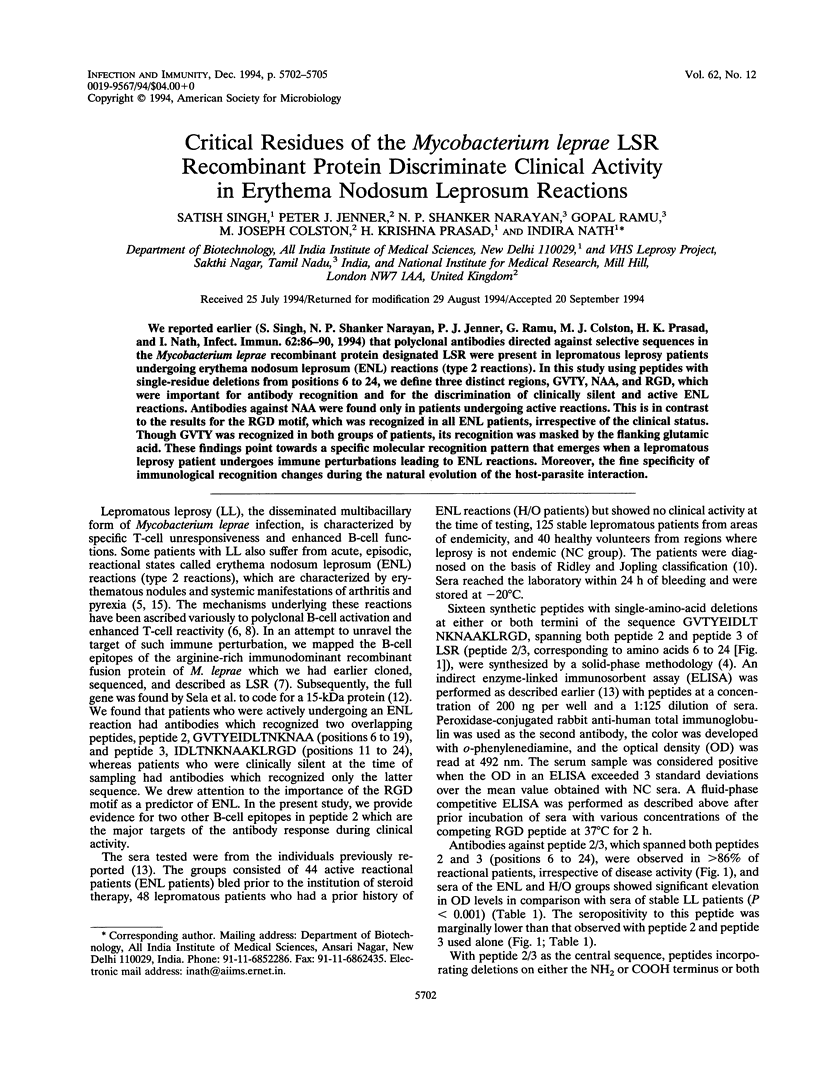Abstract
We reported earlier (S. Singh, N. P. Shanker Narayan, P. J. Jenner, G. Ramu, M. J. Colston, H. K. Prasad, and I. Nath, Infect. Immun. 62:86-90, 1994) that polyclonal antibodies directed against selective sequences in the Mycobacterium leprae recombinant protein designated LSR were present in lepromatous leprosy patients undergoing erythema nodosum leprosum (ENL) reactions (type 2 reactions). In this study using peptides with single-residue deletions from positions 6 to 24, we define three distinct regions, GVTY, NAA, and RGD, which were important for antibody recognition and for the discrimination of clinically silent and active ENL reactions. Antibodies against NAA were found only in patients undergoing active reactions. This is in contrast to the results for the RGD motif, which was recognized in all ENL patients, irrespective of the clinical status. Though GVTY was recognized in both groups of patients, its recognition was masked by the flanking glutamic acid. These findings point towards a specific molecular recognition pattern that emerges when a lepromatous leprosy patient undergoes immune perturbations leading to ENL reactions. Moreover, the fine specificity of immunological recognition changes during the natural evolution of the host-parasite interaction.
Full text
PDF



Selected References
These references are in PubMed. This may not be the complete list of references from this article.
- Chou P. Y., Fasman G. D. Prediction of the secondary structure of proteins from their amino acid sequence. Adv Enzymol Relat Areas Mol Biol. 1978;47:45–148. doi: 10.1002/9780470122921.ch2. [DOI] [PubMed] [Google Scholar]
- Geysen H. M., Rodda S. J., Mason T. J., Tribbick G., Schoofs P. G. Strategies for epitope analysis using peptide synthesis. J Immunol Methods. 1987 Sep 24;102(2):259–274. doi: 10.1016/0022-1759(87)90085-8. [DOI] [PubMed] [Google Scholar]
- Hopp T. P., Woods K. R. Prediction of protein antigenic determinants from amino acid sequences. Proc Natl Acad Sci U S A. 1981 Jun;78(6):3824–3828. doi: 10.1073/pnas.78.6.3824. [DOI] [PMC free article] [PubMed] [Google Scholar]
- Houghten R. A. General method for the rapid solid-phase synthesis of large numbers of peptides: specificity of antigen-antibody interaction at the level of individual amino acids. Proc Natl Acad Sci U S A. 1985 Aug;82(15):5131–5135. doi: 10.1073/pnas.82.15.5131. [DOI] [PMC free article] [PubMed] [Google Scholar]
- Kaplan G., Cohn Z. A. The immunobiology of leprosy. Int Rev Exp Pathol. 1986;28:45–78. [PubMed] [Google Scholar]
- Laal S., Bhutani L. K., Nath I. Natural emergence of antigen-reactive T cells in lepromatous leprosy patients during erythema nodosum leprosum. Infect Immun. 1985 Dec;50(3):887–892. doi: 10.1128/iai.50.3.887-892.1985. [DOI] [PMC free article] [PubMed] [Google Scholar]
- Laal S., Sharma Y. D., Prasad H. K., Murtaza A., Singh S., Tangri S., Misra R. S., Nath I. Recombinant fusion protein identified by lepromatous sera mimics native Mycobacterium leprae in T-cell responses across the leprosy spectrum. Proc Natl Acad Sci U S A. 1991 Feb 1;88(3):1054–1058. doi: 10.1073/pnas.88.3.1054. [DOI] [PMC free article] [PubMed] [Google Scholar]
- Modlin R. L., Mehra V., Jordan R., Bloom B. R., Rea T. H. In situ and in vitro characterization of the cellular immune response in erythema nodosum leprosum. J Immunol. 1986 Feb 1;136(3):883–886. [PubMed] [Google Scholar]
- Ridley D. S., Jopling W. H. Classification of leprosy according to immunity. A five-group system. Int J Lepr Other Mycobact Dis. 1966 Jul-Sep;34(3):255–273. [PubMed] [Google Scholar]
- Ruoslahti E., Pierschbacher M. D. New perspectives in cell adhesion: RGD and integrins. Science. 1987 Oct 23;238(4826):491–497. doi: 10.1126/science.2821619. [DOI] [PubMed] [Google Scholar]
- Sela S., Thole J. E., Ottenhoff T. H., Clark-Curtiss J. E. Identification of Mycobacterium leprae antigens from a cosmid library: characterization of a 15-kilodalton antigen that is recognized by both the humoral and cellular immune systems in leprosy patients. Infect Immun. 1991 Nov;59(11):4117–4124. doi: 10.1128/iai.59.11.4117-4124.1991. [DOI] [PMC free article] [PubMed] [Google Scholar]
- Singh S., Narayanan N. P., Jenner P. J., Ramu G., Colston M. J., Prasad H. K., Nath I. Sera of leprosy patients with type 2 reactions recognize selective sequences in Mycobacterium leprae recombinant LSR protein. Infect Immun. 1994 Jan;62(1):86–90. doi: 10.1128/iai.62.1.86-90.1994. [DOI] [PMC free article] [PubMed] [Google Scholar]
- Wemambu S. N., Turk J. L., Waters M. F., Rees R. J. Erythema nodosum leprosum: a clinical manifestation of the arthus phenomenon. Lancet. 1969 Nov 1;2(7627):933–935. doi: 10.1016/s0140-6736(69)90592-3. [DOI] [PubMed] [Google Scholar]


